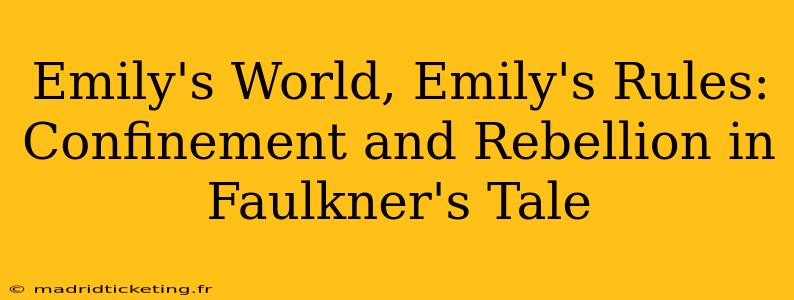Emily's World, Emily's Rules: Confinement and Rebellion in Faulkner's "A Rose for Emily"
William Faulkner's "A Rose for Emily" isn't just a Southern Gothic tale; it's a chilling exploration of confinement and rebellion, masterfully woven around the enigmatic figure of Emily Grierson. This short story, rich in symbolism and ambiguity, invites readers to delve into the complexities of Emily's life, examining how societal expectations, personal trauma, and her own fiercely independent spirit shaped her tragic destiny. We'll unpack the suffocating constraints placed upon Emily and how, paradoxically, she rebelled against them, albeit in deeply disturbing ways.
What are the major conflicts in "A Rose for Emily"?
The central conflict in "A Rose for Emily" is the internal struggle within Emily herself, fueled by external pressures. She grapples with the changing South, the loss of her father, and the societal expectations placed upon a woman of her status. This internal conflict manifests externally through her strained relationships with the town's inhabitants and her increasingly erratic behavior. There's also a significant conflict between Emily's desire for autonomy and the patriarchal society that seeks to control her. Ultimately, the story’s climax reveals the horrifying consequence of this internal and external conflict.
How does Emily Grierson represent the Old South?
Emily Grierson embodies the fading aristocratic ideals of the Old South. Her refusal to pay taxes, her insistence on clinging to outdated traditions, and her decaying mansion all symbolize the stubborn resistance to the changing social and economic landscape of the post-Civil War South. She represents a bygone era, unwilling or unable to adapt to the modern world. This resistance is a form of rebellion in itself, although a passive and ultimately self-destructive one.
What is the significance of the smell in "A Rose for Emily"?
The pervasive smell emanating from Emily's house—a "smell of dust and dampness—a sort of resistant, stubborn smell"—is a potent symbol of decay and the secrets she hides. It represents not just the physical deterioration of her home but also the moral and psychological decay that has overtaken Emily herself. This smell acts as a constant reminder of the hidden horrors within, mirroring the town's own reluctance to confront the truth about Emily's life.
How does Emily's relationship with Homer Barron contribute to the themes of the story?
Homer Barron, a Yankee construction worker, represents a potential escape from Emily's suffocating past. Their relationship, though doomed from the start due to societal disapproval and the vast differences in their backgrounds, symbolizes Emily's desperate attempt at agency and self-determination. However, her inability to accept Homer's eventual rejection leads to the story's tragic climax, highlighting the destructive consequences of her desperate clinging to control.
What is the symbolism of the strand of gray hair on the pillow next to Homer Barron's corpse?
The single gray hair found on the pillow beside Homer's skeleton is a chillingly powerful symbol. It signifies Emily's descent into madness and her ultimate act of possessive love. It illustrates the lengths to which she'll go to retain control, even in death. The gray hair underscores the passage of time, Emily's aging, and her persistent, twisted devotion to Homer.
Is Emily Grierson a victim or a villain?
Emily Grierson is a complex character who resists easy categorization as purely a victim or a villain. She's a product of her environment, trapped by societal expectations and personal trauma. However, her actions—particularly the murder of Homer—demonstrate a capacity for cruelty and a disturbing disregard for human life. Ultimately, she's a tragic figure, her rebellion manifesting in destructive and self-destructive ways. This ambiguity is what makes her such a compelling and enduring character in American literature.
Conclusion: A Legacy of Entrapment and Defiance
"A Rose for Emily" remains a powerful exploration of societal constraints and individual rebellion, prompting us to consider the multifaceted nature of both victimhood and agency. Emily's story serves as a cautionary tale, highlighting the devastating consequences of unchecked grief, societal pressure, and a desperate yearning for control. Faulkner masterfully blends horror and empathy, leaving the reader to ponder the legacy of this enigmatic and ultimately tragic woman.

